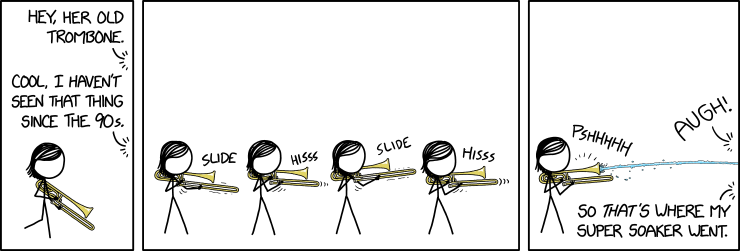
a long time ago — probably mid-1970s or thereabouts — i was at the Marrowstone Music Festival at Fort Flagler State Park (which should give those people who know about such things a much clearer idea of exactly when this occurred) for a two week “intensive”, where we learned, rehearsed, an at the end of the two weeks, performed a concert of orchestral works.
a lot of the trombone parts were mostly rests, with occasional blasts of fanfare, or glissandos, or other suchlike “trombone” things. trombones in a classical orchestra have a reputation for being lazy, and jokers, but that’s only because we have nothing else to do! nobody writes for trombones in a classical orchestra setting!
it’s true! beethoven, the quintessential classical composer, wrote NINE symphonies for “full orchestra”, but he only wrote one piece that had parts for trombones, the Three Equale for Four Trombones, which is one of the most beautiful pieces in existence.
for the most part, the classical period was before what we know as the modern “trombone” existed, and, at best, the “trombone” parts that exist are usually parts for serpent or ophecleide which have been transposed.
after one morning rehearsal — where the trombones had rests and didn’t play at all for the 4½ hours of the morning rehearsal — we were all feeling a little punchy as we went to lunch. for some time, i had been warning the other trombonists that, if they left their instruments out, on the stage, when we weren’t there, something bad could happen to their instruments… i was thinking something along the lines of “someone bumped into your horn and now the horn has a disabling slide injury that will cost several hundred dollars to repair” or something like that, and i always put MY horn away, when i was not actively holding it in my hand, but, despite my almost constant, annoying reminders, the other trombonists left their horns on the stage as we went to lunch.
so, i developed a plan…
while the other trombone players were eating lunch, i attacked their horns.
trombones that have “attachments” (i.e. every trombone that is LOWER THAN a “tenor” trombone) have at least one valve, which lowers the trombone’s pitch. when that valve is not activated (most of the time), the trombone plays in B-flat, but when the valve is activated, it plays in F (or some other key, depending on other things). most trombone players that have a valve, only use it occasionally, to play notes that they would, otherwise, be unable to play reliably. the valve section of tubing is like a separate little bit of the trombone, that is only used occasionally. it has its own tuning slide, and, when the horn is being played without the valve, the extra tubing is sealed off from the main part of the instrument.
what i did was remove the tuning slides for the valve sections of their horns, and filled the valve sections with water. then, turning the horns upside down, i replaced the valve section tuning slide, and placed the horn, right side up, on the stand, so that it looked like it hadn’t been touched.
when they came back from lunch, they picked up their horns, blew a few notes, and then cycled the valve, which released the water into the main part of their horns…
BLLLOOOOP!!!
then they “emptied their spit valves”, thinking that their horns just had water that accumulates when they went to lunch… after about 5 minutes of emptying their spit valves, they gave up, and took the slides off and dumped the rest of the water out of their instruments…
all the while i was busting a gut trying NOT to laugh, which, among other things, would have disturbed the rest of the people in the rehearsal, some of whom were actually rehearsing by this time…
and, you know what?
they never left their horns out on the stage after that… 🤣